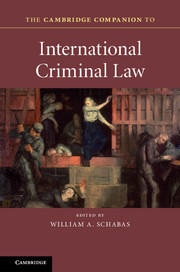Book contents
- Frontmatter
- Dedication
- Contents
- List of contributors
- List of abbreviations
- Introduction
- PART I PURPOSES AND PRINCIPLES
- PART II INSTITUTIONS
- PART III CRIMES
- 10 Atrocity crimes (genocide, crimes against humanity and war crimes)
- 11 Treaty crimes
- 12 Criminalising the illegal use of force
- 13 Children
- PART IV TRIALS
- PART V THE FUTURE
- Index
- References
13 - Children
from PART III - CRIMES
Published online by Cambridge University Press: 05 December 2015
- Frontmatter
- Dedication
- Contents
- List of contributors
- List of abbreviations
- Introduction
- PART I PURPOSES AND PRINCIPLES
- PART II INSTITUTIONS
- PART III CRIMES
- 10 Atrocity crimes (genocide, crimes against humanity and war crimes)
- 11 Treaty crimes
- 12 Criminalising the illegal use of force
- 13 Children
- PART IV TRIALS
- PART V THE FUTURE
- Index
- References
Summary
Children withstand unique harms in periods of armed conflict and similar violence. Whether infants or juveniles, during such periods children often are among the most vulnerable persons. Children typically depend on their elders for sustenance, and so the loss of parents or other guardians, coupled with the destruction of homes, displacement from communities, and deprivation of basic necessities, education, or health care, affects them acutely. Some children do not survive war; others subsist along war's waysides. Still others find themselves in armed groups, where they may be required to aid or participate in combat and, at times, to endure sexual or other physical assault. In recognition of such experiences, Raphael Lemkin, a foundational figure in the development of international criminal law, once wrote: ‘The permanent psychological injury and the arrest of normal development of the child victim is perhaps the most shocking and tragic result of genocide.’
Stories of such children have been told and retold, not only in recent memoirs like A Long Way Gone, an account of armed conflicts in 1990s West Africa, but also in much older ones like the world-famous diary of Anne Frank, a European teenager who lost her battle to hide from the Holocaust. Frank's story reflected a myriad of children's experiences during the Second World War. Nevertheless, early international criminal justice mechanisms paid scant attention to children's wartime plight. Neither the 1945 Charter of the International Military Tribunal, which tried accused major war criminals in Germany, nor Control Council Law No. 10, upon which twelve subsequent Nuremberg trials were based, made any mention of children. The same was true of the 1946 Charter establishing the Tokyo Tribunal. Even the seminal instrument of post-war collective security, the Charter of the United Nations, was silent with respect to children. In stark contrast were institutions established at the turn of the twenty-first century. The statutes of both the Special Court for Sierra Leone and the International Criminal Court place emphasis on crimes against children, and both courts have convicted individuals charged with such crimes. The initial focus, on the recruitment and use of child soldiers, eventually shifted towards a more comprehensive approach. International Criminal Court Prosecutor Fatou Bensouda has explained that ‘in addition to focusing on children who are forced to carry arms, we must also address the issue of children who are affected by arms’.
- Type
- Chapter
- Information
- The Cambridge Companion to International Criminal Law , pp. 253 - 272Publisher: Cambridge University PressPrint publication year: 2016

